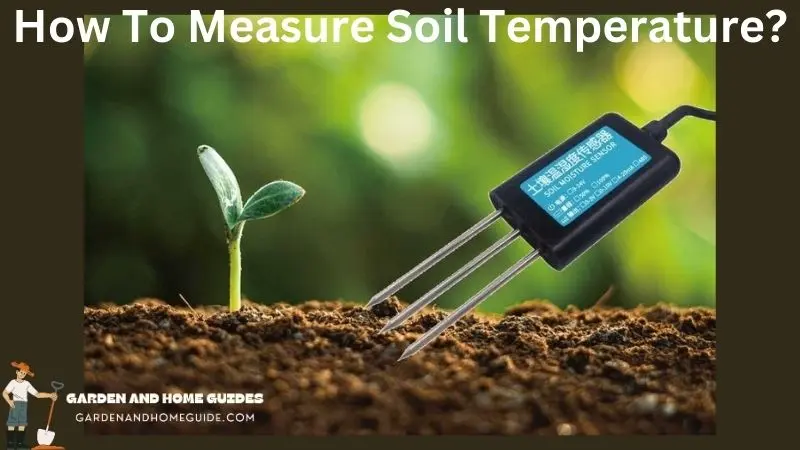Tree Care
How To Measure Soil Temperature?
Soil temperature, a seemingly simple parameter, holds immense significance in the intricate tapestry of life that unfolds beneath our feet. It governs a multitude of processes, from seed germination and plant growth to microbial activity and nutrient cycling.
Understanding and monitoring soil temperature is crucial for optimizing agricultural practices, predicting ecological changes, and even mitigating the effects of climate change. This essay of Gardenandhomeguide.com delves into the methods used to measure soil temperature, explores the reasons behind its importance, and provides guidance on when and how to conduct these measurements.
The Crucial Role of Soil Temperature
Soil temperature is a dynamic variable, constantly fluctuating in response to external factors like air temperature, solar radiation, and precipitation. These fluctuations have profound implications for the biological and chemical processes occurring within the soil.
1. Plant Growth and Development:
Soil temperature is a critical factor influencing seed germination, root development, and overall plant growth. Each plant species has an optimal temperature range for germination and growth. Temperatures outside this range can lead to delayed germination, stunted growth, or even death. For example, cool-season crops like lettuce and spinach thrive in cooler temperatures, while warm-season crops like tomatoes and peppers require warmer soil conditions.
2. Microbial Activity:
Soil microorganisms, including bacteria, fungi, and protozoa, play a vital role in nutrient cycling, decomposition, and disease suppression. Their activity is highly sensitive to temperature, with optimal ranges for different microbial populations. Low temperatures can slow down microbial activity, leading to reduced nutrient availability and slower decomposition rates. Conversely, excessively high temperatures can denature enzymes and kill off beneficial microbes, potentially leading to soil degradation.
3. Nutrient Availability:
Soil temperature influences the rate of nutrient release from organic matter and the availability of nutrients to plants. For instance, warmer temperatures accelerate the decomposition of organic matter, releasing nutrients like nitrogen and phosphorus. However, excessive heat can also lead to nutrient losses through volatilization or leaching.
4. Water Availability:
Soil temperature affects the rate of water evaporation and transpiration, impacting the overall water balance within the soil. Warmer soils tend to lose water more quickly, leading to increased drought stress for plants. Conversely, cooler soils retain moisture better, providing a more stable water supply for plant growth.
5. Pest and Disease Dynamics:
Soil temperature can influence the prevalence and activity of soilborne pests and diseases. Some pathogens thrive in warmer conditions, while others are more prevalent in cooler soils. Understanding the temperature optima for specific pests and diseases can help in implementing appropriate management strategies.
How To Measure Soil Temperature?
Several methods are employed to measure soil temperature, each with its own advantages and limitations.
1. Soil Thermometers:
Traditional soil thermometers are simple and inexpensive devices that provide a direct measurement of the soil temperature at a specific depth. They are typically made of glass or metal and are inserted into the soil to a predetermined depth. While simple to use, soil thermometers provide only a single point measurement and require manual readings.
2. Data Loggers:
Data loggers are electronic devices that continuously record soil temperature at specific intervals. They typically consist of a sensor, a data storage unit, and a display or communication interface. Data loggers offer the advantage of collecting data over extended periods, providing a comprehensive understanding of soil temperature fluctuations. They are available in various configurations, ranging from basic models with limited storage capacity to advanced units with wireless data transmission capabilities.
3. Infrared Thermometers:
Infrared thermometers measure the surface temperature of the soil by detecting the infrared radiation emitted from the surface. These devices are non-contact and provide a rapid measurement of the surface temperature. However, they are only suitable for measuring surface temperatures and do not provide information about the temperature at depth.
4. Remote Sensing:
Remote sensing techniques, such as satellite imagery and aerial photography, can be used to estimate soil temperature over large areas. These methods rely on the relationship between soil temperature and the spectral properties of the soil surface. While remote sensing provides a broad overview of soil temperature patterns, it is less precise than direct measurements.
When to Measure Soil Temperature
The frequency and timing of soil temperature measurements depend on the specific objectives and the context of the measurement. However, some general guidelines can be followed:
1. Agricultural Applications:
- Before planting: Measure soil temperature to determine if it is suitable for seed germination and plant growth.
- During the growing season: Monitor soil temperature to assess the impact of weather conditions and adjust irrigation or fertilization practices as needed.
- After harvest: Measure soil temperature to assess the impact of crop residues on soil temperature and microbial activity.
2. Ecological Monitoring:
- Seasonal monitoring: Measure soil temperature at regular intervals to track seasonal fluctuations and identify potential trends.
- Climate change research: Monitor soil temperature to assess the impact of climate change on soil processes and ecosystem function.
- Environmental impact assessments: Measure soil temperature to evaluate the potential impact of human activities on soil properties.
3. Research and Development:
- Field experiments: Measure soil temperature to assess the impact of different treatments or management practices.
- Laboratory studies: Measure soil temperature to control experimental conditions and study the effects of temperature on soil processes.
Choosing the Right Measurement Method
The choice of measurement method depends on the specific objectives, the scale of the measurement, and the available resources.
- For single-point measurements: Soil thermometers are a simple and cost-effective option.
- For continuous monitoring: Data loggers are the preferred choice, providing a comprehensive record of soil temperature fluctuations.
- For large-scale assessments: Remote sensing techniques offer a cost-effective way to estimate soil temperature over vast areas.
Factors Influencing Soil Temperature
Several factors influence soil temperature, including:
- Air temperature: Soil temperature is generally correlated with air temperature, with warmer air temperatures leading to warmer soils.
- Solar radiation: Direct sunlight warms the soil surface, leading to higher surface temperatures.
- Soil color: Darker soils absorb more solar radiation and heat up faster than lighter soils.
- Soil moisture: Wet soils have a higher heat capacity than dry soils, meaning they take longer to heat up and cool down.
- Vegetation cover: Vegetation can shade the soil, reducing the amount of solar radiation reaching the soil surface and moderating soil temperature fluctuations.
- Soil texture: Soil texture, or the size distribution of soil particles, influences the rate of heat transfer and storage. For example, sandy soils heat up and cool down more quickly than clay soils.
Managing Soil Temperature
While soil temperature is influenced by several factors, there are some management practices that can help to moderate soil temperature fluctuations and create a more favorable environment for plant growth and microbial activity.
- Mulching: Applying mulch to the soil surface can help to shade the soil, reducing the amount of solar radiation reaching the soil surface and moderating temperature fluctuations.
- Cover cropping: Planting cover crops during the off-season can help to shade the soil and improve soil health.
- No-till farming: No-till farming practices reduce soil disturbance, which can help to maintain soil structure and improve soil moisture retention.
- Irrigation: Irrigation can help to cool the soil and reduce the risk of drought stress.
- Crop rotation: Rotating crops can help to break disease cycles and improve soil health.
Conclusion
Soil temperature is a crucial parameter that governs a multitude of processes within the soil. Understanding and monitoring soil temperature is essential for optimizing agricultural practices, predicting ecological changes, and mitigating the effects of climate change.
By employing appropriate measurement techniques and implementing sound management practices, we can ensure that soil temperature remains within the optimal range for plant growth, microbial activity, and overall soil health. As we navigate the challenges of a changing climate, the importance of soil temperature measurement and management will only continue to grow.






